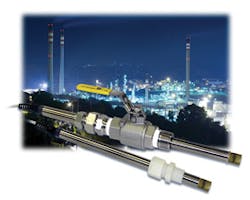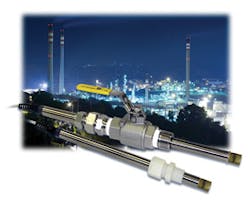Sulfide-resistant pH sensors monitor sour water in oil/gas refining operations
Engineers and technicians looking for a flexible solution for monitoring sour water containing Hydrogen Sulfide (H2S) compounds in oil/gas refineries will find the sulfide-resistant Models S10 and S17 Analytical pH Sensors from Electro-Chemical Devices (ECD) help them keep their processes and plants running efficiently.
Petroleum refiners must take care to monitor and treat naturally occurring H2S that contaminates water in their operations to meet regulatory limits. Removing H2S from the water is done through air stripping that eliminates the sulfur or oxidation reactions that convert the sulfides to sulfates. Once the water has been stripped of the sulfides it can be used in other refinery operations or be further treated as wastewater. Stripping is essential due to both the toxic environmental and corrosive effects on equipment of sulfides, which are also a common sensor poison.
ECD's S10 and S17 pH Sensor product family monitors pH in water-based solutions. The S10 and S17's Model 20005130 replaceable cartridge electrode features a pH range of 0 to 14 at temperatures from -5 to +130oC and survives pressures up to 300 psi at 25oC. It has been tested to sulfide ion concentrations of up to 25 ppm.
The S10 and S17 product line consists of two unique sensor designs and replaceable electrode cartridges. The S10 Sensor is an immersion or an insertion style sensor, and the S17 is a valve retractable style sensor. They are fully re-buildable and feature a 316 stainless steel body that incorporates the sensing cartridge, a temperature module and a signal conditioner with cabling. These cartridges provide specific solutions for the measurement of pH, ORP, specific ion (pION), dissolved oxygen, conductivity and resistivity in a wide range of industrial process applications.
The pH and ORP cartridges are available with either Radel (PES) or PEEK construction configurations with full crown, double or single tine style pH bulb protection. The pION cartridges with solid state, glass or PVC sensing membranes are suitable for continuous online measurement. The DO electrode is a galvanic cell with a lead anode, silver cathode and Teflon® membrane. The conductivity and resistivity electrodes are designed in both contacting and toroidal sensor configurations for application flexibility.
S10 Immersion or Insertion Sensor
The S10 Sensor is designed with a 0.75-inch MNPT compression fitting as the process connection. This construction feature allows a variable insertion length to accommodate installation in pipe tees, flow cells or through tank walls. If the trunk fitting is reversed, the sensor can be installed in a pipe for submersion in a tank.
S17 Retractable Sensor
The S17 Sensor is designed with a 1-inch MNPT ball valve, a 1-x-0.75 inch reducer and a 0.75 inch MNPT compression fitting to provide the process connection. Loosening the compression fitting allows the sensor to side freely through the ball valve for insertion either into the process or retraction from the process. Once the sensor is retracted, the ball valve can be closed and the sensor can be removed for maintenance or replacement without shutting down the process line.
Electro-Chemical Devices is a manufacturer of liquid analytical process instrumentation. Founded in 1977, ECD has been in business for over 30 years and has built its industry leading reputation by its commitment to customers through this basic approach: Provide quality products, develop technical innovations and provide responsive, knowledgeable service.

